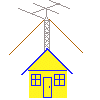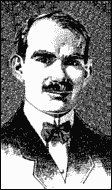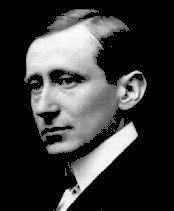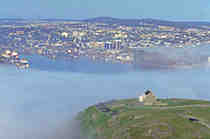




No scientific achievement is isolated, and Marconi was indebted to many people : Alessandro Volta (1745-1827), who invented the electric battery, Luigi Galvani (1737-1798), who discovered that electricity flows, and Greg Ohm (1787-1854), who gave his name to the unit of resistance and whose law relating to voltage, current and resistance was one of the foundation stones of electrical science.
OTHER PIONEERS INCLUDED;
Sir John Fleming (1904). Also, Dr. Lee De Forest (1906).  He opened the way for radiotelephones, speech, and music with his vacuum electron tube (diode). The British call it a "valve".
He opened the way for radiotelephones, speech, and music with his vacuum electron tube (diode). The British call it a "valve".  Some call him the "Father of radio". Dr. Lee De Forest stuck a bent wire into a diode's stream of electrons and got control. The modern world of electronics has it's origin in this little device.
Some call him the "Father of radio". Dr. Lee De Forest stuck a bent wire into a diode's stream of electrons and got control. The modern world of electronics has it's origin in this little device.
Born April 27, 1791 - Died April 2, 1872
Patent No. 1,647
Samuel F. B. Morse, once a portrait painter, turned to inventing to make his fortune. Morse had little training in electricity but realized that pulses of electrical current could convey information over wires.
Born in Charlestown, Massachusetts, the eldest child of the Reverend Jedidiah Morse and his wife, Elizabeth Ann Breese, Samuel Morse attended Phillips Academy in Andover, Massachusetts, and entered Yale College in 1805, graduating in 1810. Morse took out three patents on pumps in 1817 with his brother, Sidney Edwards Morse. Samuel Morse's interest in telegraphy began in 1832, and the elements of a relay system were worked out late in 1835. The equipment was gradually improved and was demonstrated in 1837.
Morse developed 'lightning wires' and 'Morse code,' an electronic alphabet that could carry messages. The patent was applied for in 1840. A line was constructed between Baltimore and Washington and the first message, sent on May 24,1844, was 'What hath God wrought!'
To support himself later in life Morse was largely dependent on dividends from
telegraph companies.In 1858 several European countries combined to pay a
gratuity of 400,000 francs as compensation for their use of his system. In
1861 the two coasts of the United States were linked by telegraph.

In 1890 at the age of 16, the Italian wireless pioneer, Guglielmo Marconi, was sending and receiving Morse code across his parents' garden without using cables. Marconi was not the inventor of wireless, but he had the foresight to envision its potential especially for the navy and merchant marines.
Under the pretense of providing ship-to-shore
communications from the Atlantic Ocean, the now established
Marconi Company built a wireless station in Cornwall
(Poldhu), England in 1900. Marconi's intention, however,
was to attempt a transatlantic wireless communication.

On December 12, 1901 in Saint John's Saint John's Harbor, Newfoundland (Signal Hill), Marconi and his associate, George Kemp, used a portable wireless to receive the letter "S" in Morse code sent by the Cornwall station.
Construction of Marconi's Wellfleet station was completed in 1903. The first message was sent on January 18 from Theodore Roosevelt to King Edward VII in England. Marconi intended to relay the message through a similar station in Glace Bay, Nova Scotia that had been in operation since December 1902. The reply, however, came directly from Cornwall making this the first two-way transatlantic wireless communication between the United States and England.
The Marconi station was on line for approximately fifteen years during which time it provided ship-to-shore and transatlantic communications. Only three years after the station was completed, however, engineers noted that the radio towers located at the edge of the large sand dunes were in danger of collapsing due to erosion. The station was closed in 1917 for security reasons during WWI; it never reopened. By 1920 erosion had rendered the two easterly towers unsafe, and the station was dismantled.
There is little left of the South Wellfleet station except some bricks and mortar locating the northwest tower foundation and the operator's quarters. A cabana housing a scaled model of the station marks the spot where wireless telegraph operators received distress calls from ships and sent broadcast news bulletins to luxury liners and Europe. Marconi chose this location for its proximity to England. He said that Cape Cod is the only place in the United Stated where you can face east and have the entire country behind you.
For a comprehensive look at the pioneers of radio going all the way back to the 1500's and the discovery of magnetism, visit the site of "Surfing the Aether" !